The Review: Classic Stage Company’s Mies Julie and The Dance of Death in Repertory.
By Ross
The winds blow in strong onto the trio of souls (+1) that share the oval tiled space in the center of Classic Stage Company‘s theatre. Surrounded on all four sides, two 19th Century Strindberg plays are getting a gusty tweak and cool twist from two very different writers; Conor McPherson and Yaël Farber. Each one is bringing forth a very different take on the tales of hate and love that was forged together by Strindberg many moons ago. These souls of his stage, in some ways, are waiting for death to resolve the issues at hand as both are condensed into one-act plays with unique and different results. It’s a tendency that works very well for one, while the other feels arbitrary and in some ways forced by some social template, pushing the tolerance of this formulation to a non-dramatic brink, when a break is almost etched into the makeup of this particular Dance. It’s surprising they didn’t take the cue from the text, as the resulting presentation might be met with a warmer reception to a cold and bitter comedy about attachment.

The Dance of Death is Stringberg’s decent into the dark corridors of the soul and the bleak manner of human attachments with a surprising and abstract sense of humor that is still firmly attached. The play was actually written as two, The Dance of Death I, and The Dance of Death II, written by Strindberg in 1900 but not intended to be performed together as there are numerous unexplained discrepancies that reside within. With this new version written by the wonderfully detailed Conor McPherson (The Seafarer, Girl from the North Country), the dark comedy of DoD 1 exists inside The Dance and is etched most elegantly in the deepest “blackest pessimism”[1] that it can find within this bitter marriage. In celebration of their 25 years together, the play begins, oddly enough, like a piece of musical theatre, literally waltzing in the eternal torment that exists within this couple’s connection. This constructed modern dance of dissension plays with your instincts, almost suggesting that the two will break out into a mournful song as the movement comes to an end. But no such luck. Or maybe that’s not true, as what exists is strong and compelling, but sadly lacks a strength and power to last to the bitter resolution.

This twinge of connection is not so surprising as this Dance of Death is directed with agility and commitment by the phenomenal musical stage star, Victoria Clark (NYMF’s Newton’s Cradle) making her directorial CSC debut. She wisely blows in the crisp coldness of the Swedish autumn night, bathing the scene in bitterness and discontent. The chill infiltrates the couple’s stark living room, designed by David L. Arsenault (as Associate, CSC’s Arturo Ui), that at moments feels more like a wrestling or boxing ring than the shared space of a marriage. Alice, powerfully played by the engaging Cassie Beck (Broadway’s The Humans) shares sharp insults and mean-spirited banter with her Edger, solidly portrayed by Richard Topol (Broadway’s Indecent). He’s a retired artillery captain who at times seem more like a tyrant crisscrossed and at odds with the persona of an adoring but jealous husband. Alice is a former actress, once glamorous now desperate, craving her lost sensuality and appeal, forever angry at what she has lost by marrying Edger, but still in need of his attention and gaze. They live unhappily, confined within a state of continued dominance and frustration, isolated on an island without any other interactions to satisfy their hungry souls. Next door to a party, but they live in a state knowing they are uninvited neighbors and disliked souls. Even within those four walls.
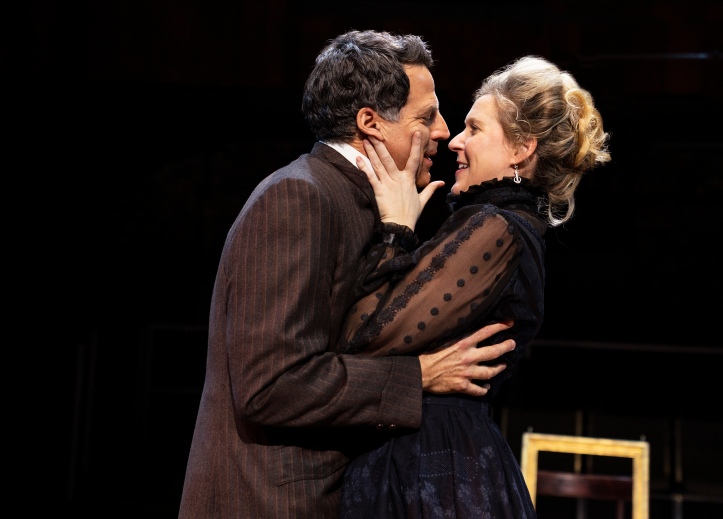
They play games and throw daggers, but a redirection in the bitter winds brings Kurt, played forcibly by Christopher Innvar (Broadway’s Victor/Victoria) entering the space with trepidation. His presence forces the two to find different tactics then they have used in all these long years dealing with their “miserable mistake“. Kurt is making a courtesy call, or so it seems, but he quickly discovers what he might have come looking for. He learns from Alice that in the past, possibly on purpose, Edger might have caused Kurt to lose custody of his own children in his equally bitter marriage and divorce. Kurt and Alice, wonderfully costumed in sometimes mourning black by Tricia Barsamian (KPOP), join forces to plot against Edgar, with revenge and hate reigniting a relationship that borders dangerously on domination and desire. Is there love, or just a power play to fulfill an empty heart? That’s a question to ponder as this complicated dance drives forward through the long gust of winds that cool their embrace.
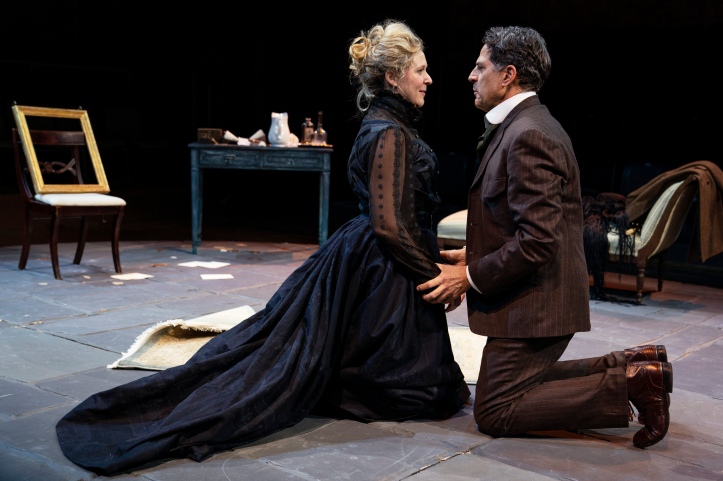
It’s a complex saga, and as the winds deliver the frigid night air, shifting the mood with a compelling lighting design by Stacey Derosier (Rattlestick’s Lewiston/Clarkston) and sound design by Quentin Chiappetta (Off-Broadway’s Irena’s Vow), the energy of conflict and hate makes us all uncomfortable guests, wondering where this all will end, and what will become of this tormented trio. Clark embraces the bleak humor of the piece almost musically, as we join with Kurt as complicit spectators to Alice playing the piano in order to get her husband to dance a bizarre and frenzied dance, with hopes that this activity might actually cause his heart problems to rise up and strike him down dead. The three embrace the darkness, the hate, and the humor, diving with glee into the dark crashing waters of that Swedish island, and even though the Dance sometimes feels forced, overly structured, and not entirely in sync with one another, the essence of the still walking and breathing corpses screaming into the cold air resonate. An obvious break in the dance about half way through feels like an intermission was built into the piece and could have easily been inserted but was chosen to be ignored. This Dance, one that lasts 110 minutes, is a bit of a slog, something right out of “They Shoot Horses, Don’t They?” when it didn’t have to be. It only made us all look at our watches and groan a bit under our breath, somewhat upset that we were only half way through, even though when “I came here, I had no anger“. When the dance, helped along by composer Jeff Blumenkrantz (Inner Voices’ Scaffolding), finally does come to an end, somewhat musically, repeating like a verse within a song, we are disturbed but gratified by the return to the attachment stalemate, watching these two frustrated codependent souls wait for death to bring peace from a pool of cruelty and absurdist humor. And within that dark ending, the bleakest of marital engagement ever examined, we find salvation, even if they only find isolation in their commitment.
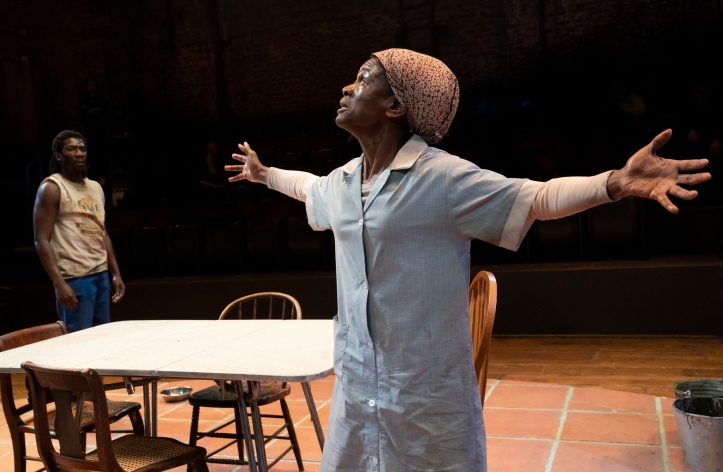
Yaël Farber (Shakespeare Theatre/DC’s Salomé) in a more daring attempt, adapts another Strindberg classic written in 1888, Miss Julie for the CSC stage, resetting the erotic dance of power onto a whole other landscape then first intended, something that might have helped McPherson. On top of the imbalances of power and gender, Farber adds race and ancestral domain rights into the dynamic attachments on display in his Mies Julie. It’s a wise move, slapping down this battleground, not in Sweden, but in the Eastern Cape of South Africa, 2012, on the evening of the annual Freedom Day Celebrations. It’s a solid and thoughtful parallel universe that gives rise to the wild and pained alliance in conflict that is at the core, although the added complexities in their passionate power struggle, as directed by Shariffa Ali (Cell Theatre’s The Year of the Bicycle), shoots Mies Julie off in a number of different directions, not always hitting their mark.
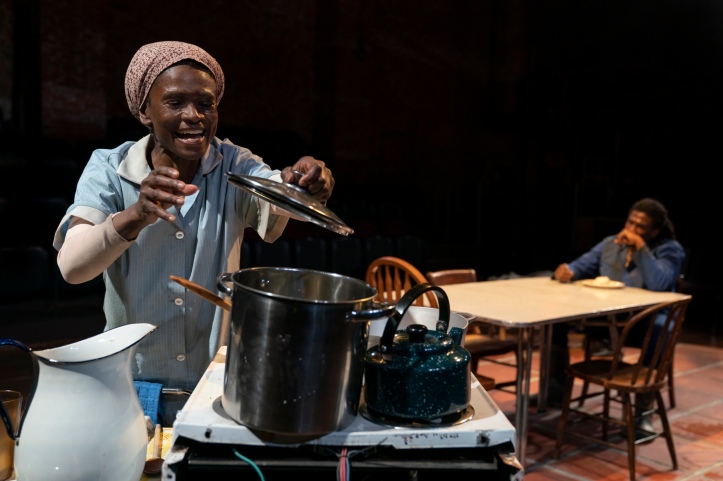
Patrice Johnson Chevannes (Broadway’s The Crucible w/Liam Neeson) is Christine, the aging housekeeper who scrubs the tiled floor of the oval, also designed and sparsely furnished by Arsenault, with similarly strong lighting and sound by the same team. It’s a house that she calls her home, working for the rich land owners that have taken control of her family’s ancestral soil, one that is watched over by her grandmother Ukhokho, hauntingly portrayed by Vinie Burrows (Foundry’s The Good Person of Szechuan) with costuming for this particular play by Ntokozo Fuzunina Kunene (Public’s Wild Goose Dreams) and Andrew Moerdyk (FIG’s Go Get the Axe). Christine and her son, John, handsomely and powerfully played by the impressive James Udom (PR’s The Revolving Cycles…) live somewhat favored lives within the rich man’s power structure, existing in a special place of affection with the white Afrikaans landowner who lays claim to the land underneath their feet. But it is in the eyes of the owner’s daughter Julie, played brazenly by Elise Kibler (Broadway’s This Is Our Youth) where a more complex dynamic exists, swallowed by all three every day with unfair bitterness and pride.
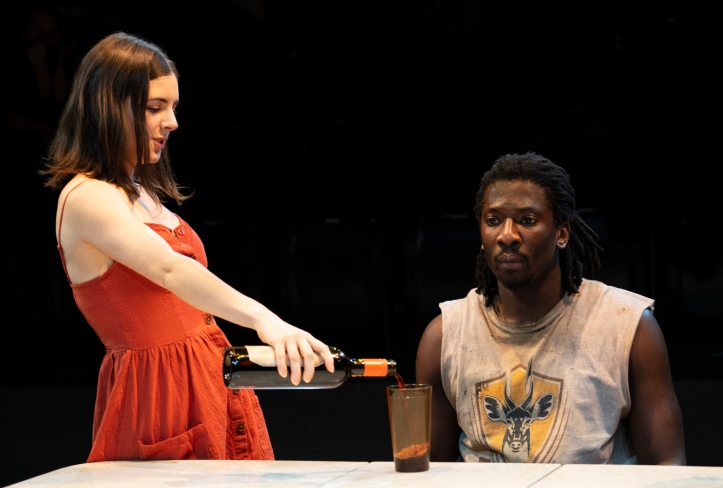
John, an Xhosa farm laborer, walks in to the oval they equally share in spirit with the Dance of Death, and greets his hard-working mother. He is by far the best thing in Meis Julie, and he does so with a sensual rawness that is hard to ignore, encompassing exhaustion, pride, and powerfulness on top of his beaten down angry soul. He’s a far step away from those bitter Swedes, although not entirely different in his brokenness, but the way his mother looks upon him is as shiny and saintly as a prayer. He’s “too proud“, she says, but “not proud enough“, she thinks. Julie, the landowner’s daughter, also can’t help herself in the way she looks at John, but in her eyes there is a struggle between a desire to control and an ache to be taken and used. And thus, their dance to the death, to a musical score by composer Andrew Orkin’s (“Dead Pigs“), begins with a too eager earnestness, as Kibler’s Julie lays herself down far too quickly to take in. Her Julie is beautiful, but lost in a fog, playing it too fast and furious in the way she jabs at him with unabashed cruelty. We are supposed to, I believe, like her even with her spoiled brattiness at full display. Without that attunement, the end results loses its way. Like the married couple in the other Strindberg play, the love and hate that is forged between them is as vicious at times as possible, hiding the opposite underneath, but with these two, there are the roots of lust and want, born many years prior, that will never go away. They are long and storied, but entangled and possibly rotten and destroyed by the graves of John’s ancestors buried underneath the house, that these gnarled roots have grown through and inhaled their mistrust and anger.

Strindberg described his two lead characters, Miss Julie and Jean at war in an evolutionary and stylistically natural battle for survival of the fittest. The character, Miss Julie, represents what remains of the old aristocratic breed about to fall away on the road to modernity, whereas Jean, the manservant to the Count, represents the modern man fighting his way up and out of the confines of the century’s old power dynamic. He’s seen as far more fit to survive because he is better equipped to adapt to the changing world order. The same can be said of these two Farber creations. The winds of change, much like the cold autumn gusts that unsettle the dust of the Dancing duo in Sweden, are sweeping across South Africa, awakening an anger and thirst for triumphant survival over their oppressors. John and Julie are forced to do battle for dominance in the same manner as Julie and Jean, but with added complexities. Farber has altered the dynamic of the ending, and I’m not all together sure why the shift is needed. Maybe the descent into destruction of the old power structure is self-inflicted, or something akin to the same defeat that both Edgar and Alice decide to embrace. I’d love to know the logic behind that restructuring, but the end result is as significant in its solidarity to the environment as it is to these two characters. Only John and the Swedish Kurt find their way out of Death’s waiting room, escaping the tediousness of union and erotic bondage. We also escape into the new world order, after two consecutive nights of adapted Strindbergs. Both are not without their flaws, although they each share a damaging wind shift that impacts the demanding attention that needs to be paid. Death awaits us all, but do we sit and wait for it to come a-callin’? Or do we act in desperation to save our unsatisfied souls? You tell me, but even though I enjoyed the descent, I’d personally rather rise up and face the gale force of nature and death.
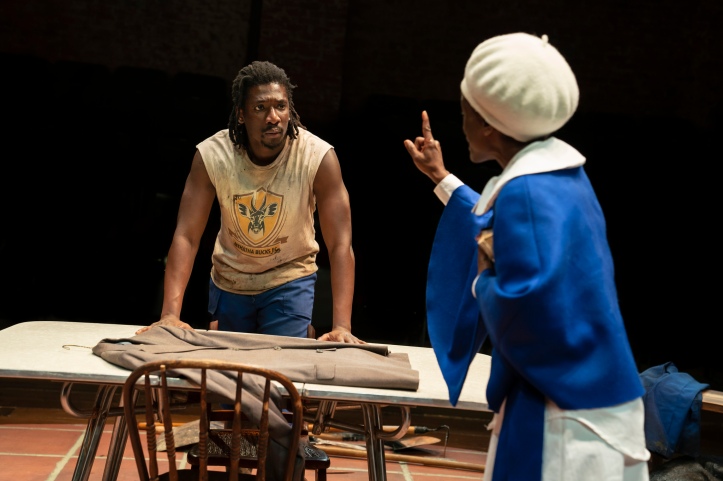
1- Strindberg, August. Meyer, Michael, translator. Strindberg Plays: 2: Dream Play; Dance of Death; The Stronger. Introduction. A&C Black. 2014.
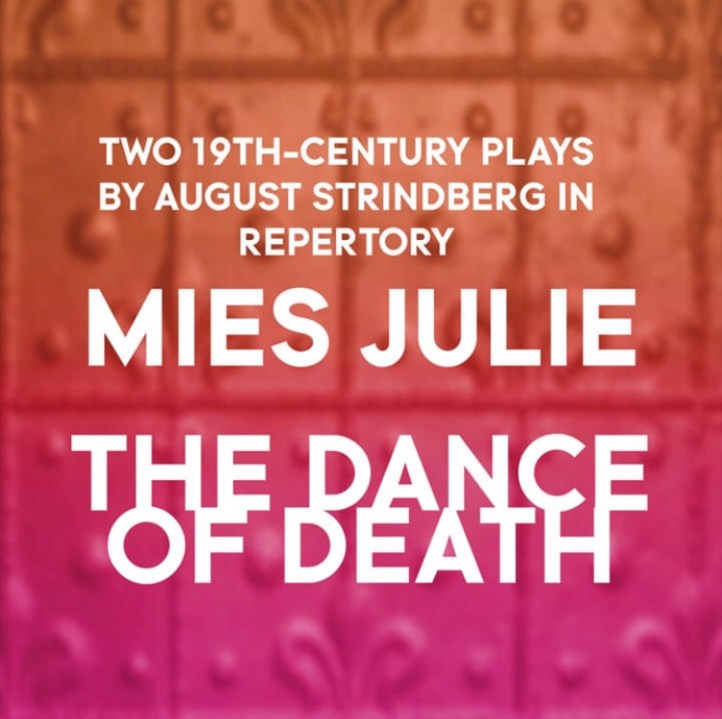
[…] underneath the bruised skin by Yaël Farber (Donmar’s Knives in Hens, CSC’s Mies Julie), a subtle elegance can’t be […]
LikeLike
[…] rough and dirty play, as directed by Yaël Farber (Donmar’s Knives in Hens, CSC’s Mies Julie) with tenderness and forcefulness underneath the bruised skin of these wanderers, a subtle elegance […]
LikeLike
[…] Todd), with impeccably harsh and intentionally sporadic lighting by Stacey Derosier (CSC’s Mies Julie/Dance of Death), a detailed sound design by Tyler Kieffer (The Flea’s Sound House), and a devastatingly […]
LikeLike
[…] Todd), with impeccably harsh and intentionally sporadic lighting by Stacey Derosier (CSC’s Mies Julie/Dance of Death), a detailed sound design by Tyler Kieffer (The Flea’s Sound House), and a devastatingly […]
LikeLike
[…] and celebrating the rise of their older brother, Joe, strongly played by James Udom (CSC’s Mies Julie) to the honored position of Pastor, all with the help of their neighboring maternal figure, Mama, […]
LikeLike
[…] wife, Abasiama Ufot, dynamically played by the phenomenal Patrice Johnson Chevannes (CSC’s Mies Julie) hiding herself under a mountain of blankets. She’s trying to keep warm in a cold house, but […]
LikeLike
[…] his wife, Abasiama Ufot, dynamically played by the phenomenal Patrice Johnson Chevannes (CSC’s Mies Julie) hiding herself under a mountain of blankets. She’s trying to keep warm in a cold house, but the […]
LikeLike